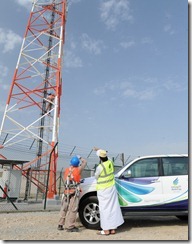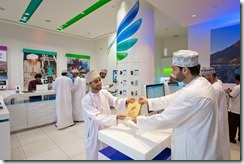Despite a stock market share price that is languishing at more than 30 per cent below the level it listed on the Oman bourse in November 2010, Nawras continues to be an energetic operator that is looking to maximise the opportunities data usage represents. Through the leveraging of its various access technologies and the bundling of products and services, Nawras continues to expand its base of operations, believing such a focus will generate the necessary good results 
Cormack freely admits that the competitive landscape in Oman has become more aggressive in the last few years, not least through the presence of value-focussed resellers together with the omnipresence of a well-entrenched incumbent
Nawras CEO, Ross Cormack believes the telco has the necessary positive momentum to continue propelling the company forward in Oman, despite coming through a tough operational period that has impacted its financial performance as well.
In the first quarter of 2012 the telco reported revenues fell by 2.7 per cent to OMR46.8 million (US$121.6 million), while net profit also fell by 19.1 per cent to OMR9.8 million.
The company’s total subscriber base rose by 2.4 per cent year-on-year to reach 1.99 million.
Nawras attributed the fall in revenues to a reduction in SMS revenues that was not fully compensated by growth in data revenue. In addition, revenue in Q1 2012 included a one-off accounting adjustment of OMR658,000.
The second quarter of 2012 marked a stabilisation in Nawras’ operational and financial results, though the telco’s first half performance still highlights the competitive nature of the telecom market in Oman, and the on-going pressure on margins. Nawras closed the six months to end-June with a customer base of 2.03 million, representing a 4.4 per cent growth rate.
The fixed service customer base grew by nearly 176 per cent during the half to 36,787 customers, though Nawras’ overall revenue for the period was down 1.7 per cent to OMR95.3 million, delivering a net profit of OMR19.5 million, down 11.8 per cent from OMR22.1 million a year earlier.
“We recently moved into new open plan office space, the Nawras Campus, where our people can see one another and easily interact,” Cormack told Comm. “It is a fantastic location for us to be able to make decisions quickly and there is a palpable energy that drives us.”
Cormack freely admits that the competitive landscape in Oman has become more aggressive in the last few years, not least through the presence of value-focussed resellers together with the omnipresence of a well-entrenched incumbent.
Nawras’ competitive approach appears to be based on focussing primarily on the factors within its own control, more so than looking to what other players are doing in the market and reacting to those factors.
“It would be fair to say that in some areas the huge increase in use of data in Oman outstripped our ability to provide it,” Cormack acknowledged. “We probably did not build as fast as we should have done but that is all changing now and going forward, we are confident that we will manage and support the growing data demand. We also have new people in our top line up, with a world leading CTO and CMO contributing additional expertise from worldwide markets.”
Part of Nawras’ plan to keep abreast with the surging demand for data is a project it describes as ‘turbocharging’ its network, which in essence means upgrading the network for increased capacity and performance.
To this end, at the end of June Nawras announced it had entered into an agreement with Huawei to upgrade its Radio Access Network (RAN) by advancing all sites to enhanced 3G+ and increasing coverage, in-building penetration, capacity and the speed of the entire network. At the same time Nawras said it would be launching 4G LTE technology.
Nawras is deploying a LTE FDD 4G network in the 1800MHz spectrum band, and together with the Telecommunications Regulatory Authority’s release of two more 3G+ frequencies, the telco is looking to at least triple its mobile broadband capacity. This upgrade programme is due to begin in August in Al Amerat.
Around 30 per cent of sites are set to be upgraded before the end of the year and customers are forecast to immediately notice the difference as they start to receive fast 3G+ and 4G services. The 4G LTE network will cover all major areas of Muscat governate including Ruwi, the central business district, Wadi Kabir, Muttrah, Qurm, Azaiba, Al Khuwair, Ghala, Baushar, Mawaleh and The Wave, by the end of the year. All major cities will enjoy LTE coverage by June 2013.
In addition to the launch of 4G LTE, 3G+ population coverage will rise dramatically from 53 per cent to 97 per cent over the next three years including greater coverage in remote areas across Oman. At the same time as new 3G+ sites are being introduced, the WiMAX home broadband network will be extended further.
“Over the coming 2-3 years we intend to turbocharge every base station, resulting in 97 per cent of the population having 3G+ access,” Cormack confirmed. “Hundreds of such base stations will be running by year-end, with an overlay of 4G at 1800MHz also being introduced in the major cities.”
At the end of June Nawras announced it had entered into an agreement with Huawei to upgrade its Radio Access Network (RAN) by advancing all sites to enhanced 3G+ and increasing coverage, in-building penetration, capacity and the speed of the entire network
Cormack broadly describes the telecom sector as being at an inflection point given the growth and prevalence of over-the-top (OTT) players, with social networking and the consumption of video content via Internet-based companies such as YouTube accounting for the majority of today’s data demand.
Nawras’ broadband network development approach is a diversified one, incorporating a number of access technologies spanning mobile, wireless and fixed-line. Last October, for example, the telco began offering a free trial of high-speed broadband to around 200 customers living in Al Mabailah North. For a three month period, customers were invited to experience the benefits of Fibre-To-The-Home (FTTH) with download speeds of between 10-100 Mbps.
The telco is working with Haya Water Company and the TRA to implement the fibre optic technology needed to provide high-speed broadband.
A selection of four different FTTH pricing plans offering a variety of different speeds were trialled to enable Nawras to fine tune its offerings ahead of the full commercial launch of the service, though Cormack describes Nawras’ activities in this area as being in “relatively early days”.
Nawras also continues to court the business segment in Oman, particularly the small and medium sized enterprises, and the 40 per cent segment of the business market that is non-government-related, where incumbent Omantel enjoys distinct advantages. Nawras has developed an offering of cloud services for small and medium sized enterprises, for example, and is pushing its global VPN offering as well. The introduction of fixed number portability for corporates is another development Nawras expects to benefit from.
On the consumer front, Nawras offers a plug-and-play home broadband service over WiMAX, while its consumer mobile business is focussed on the offer and delivery of bundles and segmentation efforts that differentiate the telco’s services in the market more effectively.
For instance Nawras has devised a discounted international calling number, and earlier this year launched a promotion whereby 800 Bz spent by a subscriber on Nawras services in a day would be rewarded by an additional 800 Bz of credit to be used on that day. Nawras has also devised bundled services to tie-in with the hugely popular Samsung S3 device, users of which are typically high data consumers.
“With respect to our operations in the business market, we believe it is all about relationship building. We are developing the corporate market with the offer of global connections, innovative services like Business Mousbak, which permits calls within a company including prepaid at no additional charge, as well as desktop self-care,” Cormack said.
Strategically, Cormack says Nawras’ priorities include the addition of content and greater participation by the operator in the value added services ecosystem. The telco is also placing significant emphasis on reducing the cost of churn, and as Cormack likes to describe it, “delighting customers”.
Strategically, Nawras’ priorities include the addition of content and greater participation by the operator in the value added services ecosystem. The telco is also placing significant emphasis on reducing the cost of churn, and “delighting customers”.
The floundering share price, however, does remain a cloud over Nawras’ operations. Having become a publically listed entity with much fanfare and excitement, the stock has consistently lost value, knocking almost US$400 million off of the value of the company in the less-than-two years since listing.
Despite this disappointment, Cormack remains optimistic for the company’s future, and insists that should Nawras continue to improve upon its operational activities and innovate; this effort will be reflected in an improved stock price.
“I am confident that the ingredients we are putting into the company right now are allowing us to go into this exciting new world of data in an energetic way and I firmly believe we are on the right path to achieving the right results,” Cormack said. “We shall continue to focus on improving the range and quality of the services we provide, on improving our operational performances and delighting our customers. I am confident that the share price should duly reflect the good work that is being achieved and the progress that is being made.”





0 comments ↓
There are no comments yet...Kick things off by filling out the form below.
Leave a Comment